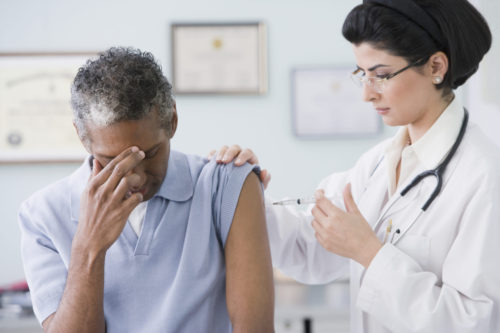Everyone six months and older should get the vaccine
This fall, lots of people will brush off their physician’s advice to get vaccinated against the flu virus. Why? Because of a complete myth that getting vaccinated can give you the flu.
According to the Centers for Disease Control and Prevention, flu outbreaks can happen as early as October—and contagious influenza causes millions of illnesses, hundreds of thousands of hospitalizations and thousands of deaths every season. Each year, vaccines are updated to better match the circulating viruses.
This year’s vaccine is a trivalent vaccine and it protects against three flu strains: H1N1, H3N2 and influenza B. Some of the 2015-16 vaccine is also a quadrivalent vaccine—this means it will protect against four different strains. The CDC recommends everyone six months and older receive an annual flu vaccination.
“Getting vaccinated is the best way to protect yourself from the flu,” says John Quarles, a professor in the department of microbial pathogenesis and immunology at Texas A&M Health Science Center College of Medicine. “You absolutely cannot get the flu from the standard vaccine shot. A flu shot is made up of antigens. Antigens are not genetic material and therefore they cannot replicate.”
Flu vaccines are currently made in two ways: from a flu virus that is “inactivated” and therefore not infectious, or with an attenuated (weakened) virus—as is the case with a recombinant vaccine.
The nasal spray flu vaccine—or FluMist—is considered a “live virus” vaccine. “The viruses in this vaccine are weakened and cannot cause flu illness,” Quarles says. “These vaccines are made with a temperature sensitive mutation, which means they cannot reproduce above a temperature of 33 degrees Fahrenheit. The flu virus wouldn’t grow in your lungs, even if it wanted to, because our body temperature is higher than 33 degrees.”
“It’s also common for patients to mistakenly assume they have the flu because the term ‘flu’ is thrown around indiscriminately in reference to respiratory illnesses,” Quarles says. “Often people say they have the flu when they really have a cold, and unfortunately, even some physicians use these terms interchangeably.”
Quarles notes some people might experience flu symptoms after a vaccine because they were incubating or harboring the virus in their bodies. However, these instances are very rare. “It’s far more likely a person will have a reaction to the vaccine and assume they have flu,” he says. “Side effects like tenderness, swelling or redness at the flu shot site, low-grade fever and aches are common after receiving a vaccine.”
The CDC states if these problems occur, they will often begin soon after a vaccination and are usually mild and short-lived. According to Quarles, if you are stricken with the flu, you will know. “There is nothing mild about the flu virus,” he adds. “It can be particularly nasty and you will be extremely sick.”
Depending on the effectiveness of this year’s vaccine, there is a small chance you could still contract the flu even after vaccination against it. These cases normally happen because someone was exposed to a different flu strain or because some individuals simply don’t show a good immune response.
Quarles emphasizes that it’s always important to check with your health-care provider if you experience any flu-like symptoms and that people who choose not to receive a vaccine will have zero protection against this year’s flu epidemic.
It’s also important to recognize that as influenza viruses change rapidly, the threat of a global pandemic is always a concern to researchers. While rare—only occurring three times in the 20th century—influenza pandemics can be deadly, as humans have little to no immunity to a new virus, and there is no readily available vaccine.
“While the seasonal vaccine is updated yearly to protect against currently circulating influenza viruses, it will likely not protect against newly emerging pandemic flu outbreaks,” Quarles says.
Although the next strain of pandemic flu cannot be predicted, the capability to respond exists thanks to three government-funded biodefense centers. The Texas A&M Center for Advanced Development and Manufacturing, for example, will have the capacity to supply 50 million vaccine doses within four months of receipt of a pandemic influenza strain, with the first doses available in 12 weeks.
“Vaccines like this are the real success stories of medicine,” Quarles says. “They have saved countless lives and wiped out many deadly epidemics. The public should not fear them.”
From Futurity






